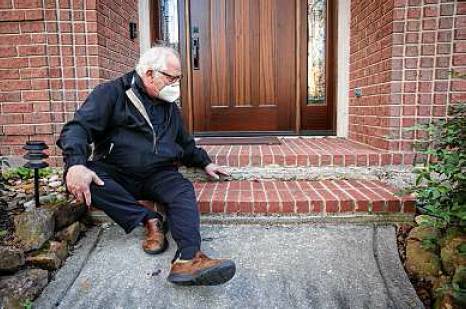New groundwater rules could sink homes in The Woodlands by a foot
By Emily Foxhall STAFF WRITER
THE WOODLANDS — The front half of Mark Meinrath’s home is sinking. He knows because he had it lifted up and leveled three times. His crepe myrtle sits well above his lawn, pushed up by its roots from where the earth sloped down. Almost all the concrete slab is exposed; he added an extra step to reach his front door.
The front part of the brick home, built in 1992, fell about a half inch a year, Meinrath said. Then relief came, when new rules in 2016 slowed how much water was being pumped from underground in Montgomery County. The sinking slowed. But when new local groundwater officials were elected and tossed those pumping reduction rules amid rising water bills, Meinrath said, his house began sinking quickly again.
Future help that Meinrath, 72, might have hoped for didn’t come Wednesday. Regional groundwater officials unanimously adopted new guidelines that will continue to allow so much well water to be pumped that areas of The Woodlands and northern Harris County could sink in coming decades by more than a foot. Someone whistled in celebration after the vote, the result of years of rigorous work.
Meinrath joked that that much subsidence would leave his house, now supported with underground concrete piers, looking like a beach house. It sits over a fault line, he said, making the sinking ground evident because it’s happening unevenly on either side. “You’ve destroyed my home,” he said, referring to the local water board.
The vote from members of Groundwater Management Area 14, an entity that is supported by the Texas Water Development Board, disappointed those who fought for a more cautious approach to groundwater regulation. Land subsidence cannot be reversed and can damage public and private property, such as Meinrath’s house. It also can worsen flooding. The value of Meinrath’s home plummeted.
Yet the GMA’s decision satisfied Republican-led Montgomery County officials, who in recent years abruptly eliminated requirements similar to those in Harris and Galveston counties to transition the area to use more treated lake water instead of so much well water. Those in Montgomery County plan to continue studying subsidence but for now allow users to pump as much water as demand requires.
The differing perspectives reflect a debate over how to balance the cost of water against damage to the environment. It’s much cheaper to pull water up from underground because it doesn’t need to be treated as heavily. But if too much is pumped, the water can get harder to reach and the ground can sink. How much is too much, and who should decide that, is hotly contested.
In Harris and Galveston counties, leaders decades ago realized the harm from pumping too much. An entire subdivision famously sunk into Galveston Bay. Officials began phasing in treated lake water as a main source of drinking water and continue to shift toward its use. They recently finished a 26-mile series of pipes and canals to bring more water from Trinity River to Lake Houston.
Previous water boards in Montgomery County, a suburban and rural area north of Houston, planned for years to do the same as the population grew. They aimed to use only as much water from underground as would be naturally replaced. This required a water treatment plant to supplement supply, which the San Jacinto River Authority built in 2015 for $480 million.
Water costs went up, however, angering some and prompting a change in law to allow for a utility-backed election of new leadership. Board members of the Lone Star Groundwater Conservation District in Montgomery County pivoted entirely from what former leaders did. The board did not follow the last set of regional guidelines, after they faced legal challenges locally.
Lone Star is one of five water management groups that make up GMA 14. There are also two non-voting groups, the Harris-Galveston and Fort Bend subsidence districts. Together, they represent 20 counties. Because groundwater is a shared resource, state law requires them to set big-picture goals collaboratively.
Wednesday’s vote on new guidelines means Lone Star will have to manage according to the shared goals. They have two years to devise a plan for that and another year to implement any rules that are needed. The new guidelines may not require them to make any changes at all.
Samantha Reiter, general manager of the Lone Star district, stressed that the guidelines allow for local control. She noted that users in The Woodlands, a master-planned community of about 115,000 residents that is part of the area Lone Star manages, could always choose to use more water from the new water treatment plant on Lake Conroe even though it’s not required.
“There is not a one-size-fits-all in the groundwater world,” Reiter said.
The adopted guidelines give individual districts two metrics, which Lone Star pushed to be linked with “or” instead of “and.” None can use more than 30 percent of the average available water underground by 2080. Or none can see more than a foot of subsidence on average between 2009 and 2080. (The former is thought to be the limiting factor for Montgomery County.)
Mike Turco, general manager of the Harris-Galveston Subsidence District, called inclusion of the subsidence metric “a step in the right direction.” He said he expected that as growth continues in Montgomery County, more people will see subsidence as an issue because it will occur in places that it hadn’t in the past.
A regional goal-setting process will meanwhile restart. They are updated roughly every five years. Meinrath and neighbors such as Laura Norton, 51, will be watching. Norton tried to drum up support from neighbors this time around to call for change to the proposed rules. She gave tours of subsidence to anyone willing to learn, including some from her water aerobics class.
“My hope,” Norton said, “is that in the next five years we get our act together.” emily.foxhall@chron.com

